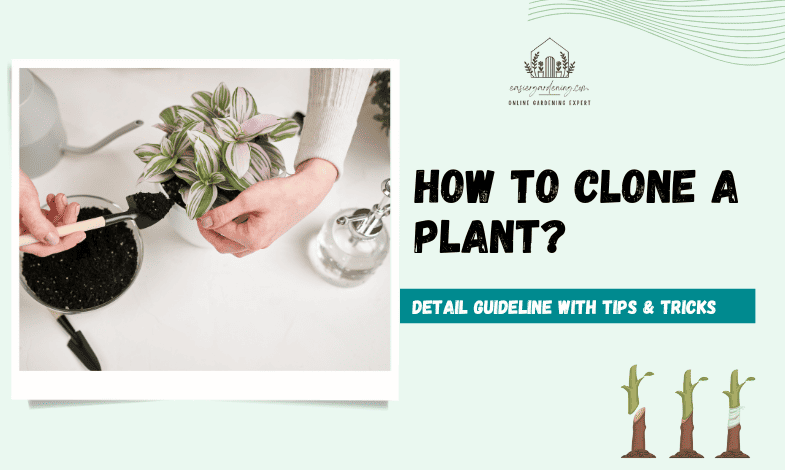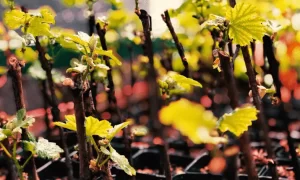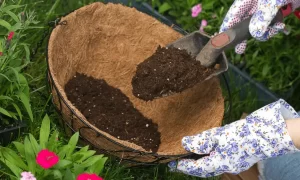How to Clone a Plant? Detail Guideline: You may think cloning a plant is very difficult. But to be honest, plant cloning is a simple process that allows you to reproduce a plant by cutting its stem and replanting it. First prepare a suitable container, soil, and rooting hormones for your plant before cutting, planting, and covering it. Make sure you have the right growing conditions for your plant to thrive. In this article, we are going to demonstrate how to clone a plant.
Contents
Gather the Right Materials
Choose a container for cloning. The size of the container will depend on how big the plant will grow and how many plants you want to plant in one container. Do a little research on your plant at the beginning to find out how big the container should be for plant cloning. Some prefer to clone plants in pots, while others simply use a plastic cup with holes in the bottom to do so.
Tips: A clear container is usually best. That way you can see when and where the plant is rooting.
Consider whether you want to clone the plant in Rockwool or soil.
To clone plants, you place a piece of a plant in soil or Rockwool so the new plant can root and grow.
- Rockwool is more involved and requires more preparation than soil. It needs to be soaked overnight in water with a pH of 4.5, and it doesn’t contain as many nutrients as natural soil. Also, you’ll need to cut a hole in the center of the Rockwool that’s not too big and not too small for the plant you’re cloning.
- You can use potting soil, seed starting mix, or well-composted garden soil for your plant. Regular soil that you dig up from your garden may not be optimal.
Read more about How to make plants grow fast?
Decide whether or not you want to use a rooting hormone. Rooting hormones are used during cloning to speed up the growth of the plant. Plants contain natural hormones called auxins that determine whether the plant will grow more leaves or more roots. Rooting hormones from the bottle are synthetic auxins. When you apply auxins, it’s a signal for the plant to make more roots. This starts the process of cloning.
- If you’re an organic gardener, you probably won’t be a big fan of rooting hormones. Many rooting hormones contain fungicides and chemicals that aren’t necessarily environmentally friendly. If you want to avoid using chemicals in your garden, you can opt for natural alternatives, like willow tea, cinnamon, or diluted apple cider vinegar.
- Plants like tomatoes are easy to clone because they produce a lot of natural auxins, but for other plants, roots may only grow from the root ball at the top of the stem and it may be difficult to root the plant without a synthetic hormone. Before making a decision, research your plant to be sure what is the best choice in your situation.
- Never dip plant parts directly into the container of the hormone. Take only the amount of hormone you need from the package and follow the enclosed instructions to apply it to the plant. This way you will avoid contamination of your supply.
How to Clone a Plant? Planting the Stem
Fill the Pot or Container with Soil or Rockwool
- If you chose soil, fill the container to the brim. Poke a hole through the center, down to the bottom of the container.
- If you chose Rockwool, you can simply insert the Rockwool ball into the container.
Water the soil
When it comes to how to clone a plant, watering properly is needed to be ensured. Water the soil with enough water so that it is wet, but not soggy. If you are using Rockwool, you already had to soak it overnight, so you don’t need to water it now.
Cut the stem of the plant diagonally with a sharp knife or scissors. Cut off side branches, not the main stem. The main stem is the stem of the plant that grows out of the ground. Side branches grow out of the main stem.
- After you cut your cutting, remove all leaves and flower buds from the stem. If there are too many leaves or buds on the cutting, they will suck much of the water out of the stem and the plant will not be able to root.
Dip the Cutting in Rooting Hormone
Rooting hormones are available in liquid or powder form. If you use powder, dip the stem in a little water and then apply the powder to its end so that it sticks. Do not cover the entire stem with the rooting hormone. Only lightly coat the bottom of the cutting. Place the stem of the plant in the hole in the soil or Rockwool. Try to put about one-third of the stem into the hole.
Learn more about Harvesting Wheatgrass At Home
Cover the container with plastic or glass. A plastic bag often works well enough if you have nothing else on hand. If the plant is covered, it won’t lose moisture. This allows it to live on while it tries to grow roots. What you use to cover the plant depends on the type of container you clone your plant in.
Grow
Controlling the right amount of light for plant cloning is very important. Place the container in a warm place with ETWAS of sunlight. Exposing the plant to direct sunlight all day can put too much stress on the cutting and kill it. Water the soil a little each day and keep it moist (but not soggy) while the cutting begins to root. After about a week or two, the plant should have started to form roots. Hooray! Cloning has been successful.
Special Tips: How to clone Plants
In this guide on how to clone a plant, we will finish with some special tips which are needed to keep in mind to get the best out of plant cloning.
- A good stem for cloning can be bent instead of cut and will break cleanly. A flexible stem may be too old to root successfully. A soft or flexible stem, on the other hand, maybe too young. If you can’t find a perfect stem to grab, try to find one that’s as healthy as possible and cut it off with a knife.
- After you cut the stem, carefully scrape down its side. This will allow more auxins and nutrients to enter the stem and help the plant develop roots.
- Choose a stem that has at least 3 leaf shoots. More shoots are a sign of good overall health and energy. Remember that larger cuttings require more resources to survive. Finding a middle ground is always a matter of experience and also depends on the plant you are working with.
- Plant the stem so that one or more leaf shoots are covered with soil. You can’t do that with Rockwool, of course. Many plants form new roots more easily from leaves than from stems. Also, the more of the underground plant, the more room it has to form new roots.
- If you have decided to use rooting powder and soil, it is advisable to wrap a (moistened) cloth around the root after applying the powder. This will prevent the hormone from stripping off when the stem is placed in the soil.
- Choosing which stem to cut from the parent plant is not easy because you probably want to keep them all. It’s best to choose one from the lower area that doesn’t get enough sunlight to grow well. Keep in mind that each leafy shoot on a plant is a separate plant that needs sun to grow and produce new shoots & flowers/fruits. This means that the lower stems/branches are never particularly productive and should be removed anyway, as they only deprive the rest of the plant of water and nutrients.
Learn more about the Most profitable plants to grow in a Greenhouse?
Frequently Asked Questions
What are the 3 Types of cloning?
The 3 types of cloning include —
- Recombinant DNA Technology (DNA cloning)
- Reproductive Cloning
- Therapeutic cloning
When should you Clone a Plant?
It is recommended to transplant the clones when they’ve developed at least 3–5cm long and strong roots that are.
Can you Clone plants forever?
Yes, as long as the plants are healthy. There is actually no limit to how many times you can clone a plant continuously.



